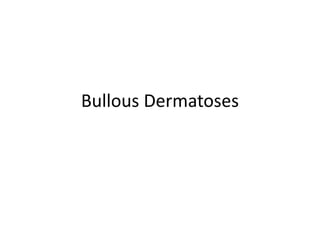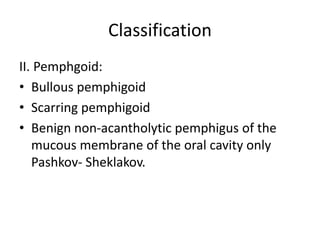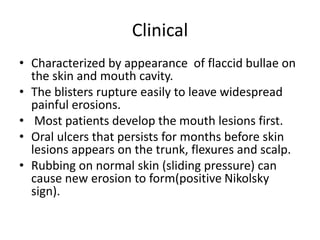–ª–µ–∫—Ü–∏—è.pptx for std dermatovenerology, cause and symptoms
- 2. Bullous skin diseases • The group of bullous dermatoses is very diverse both in the clinical picture and in its etiological and pathogenetic essence, but they are united by a single primary morphological element- a bubble that appears on the skin and visible mucous membranes.
- 3. Classification I. True Pemphigus • Pemphigus vulgaris • Vegetative pemphigus • Pemphigus foliage • Erythematous pemphigus • Brazilian pemphigus
- 4. Classification II. Pemphgoid: • Bullous pemphigoid • Scarring pemphigoid • Benign non-acantholytic pemphigus of the mucous membrane of the oral cavity only Pashkov- Sheklakov.
- 5. Classification III Herpetiform dermatoses ‚Ä¢ Herpetiform dermatoses of ∂Ÿ√º≥Û∞˘æ±≤‘≤µ ‚Ä¢ Herpes of pregnant women ‚Ä¢ Subcorneal pustulosis IV. Benign-family familial pemphigus Guzhero- Haley-Hailey V. Transient acantholytic dermatosis of Grover
- 6. True Pemphigus • Prmphigus is more characteristic of women. • The disease is much more common in married families. • The first manifestation of dermatosis is usually observed after the age of 50, although there have been observations of its occurrence at a younger age and even isolated cases in childhood.
- 7. Clinical and morphological and histopathological signs that are characteristic of all clinical forms of disease are: 1. A long chronic undulating course of dermatoses with the development of blisters, which tend to generalize and merge with each other, accompanied by a violation of the general condition of patients, before the use of corticosteroid therapy often ends fatally 2. The general mechanism of bladder formation by acantholysis
- 8. 3 The intraepidermal arrangement of the bubbles: suprabasal with vulgar and vegetative pemphigus and subcornal or supra intragranular with leaf-shaped and erythematous pemphigus. 4 Deposition of immunoglobulins of class <3 in the intercellular space of the epidermis. Etiology and pathogenesis a true pemphigus is still unclear. The following theories are available: Neurogenic, Viral, Exchange, Endocrine, Autoimmune
- 9. Clinical • Characterized by appearance of flaccid bullae on the skin and mouth cavity. • The blisters rupture easily to leave widespread painful erosions. • Most patients develop the mouth lesions first. • Oral ulcers that persists for months before skin lesions appears on the trunk, flexures and scalp. • Rubbing on normal skin (sliding pressure) can cause new erosion to form(positive Nikolsky sign).
- 10. Nikolsky Sign : Dislodging of epidermis by lateral finger pressure in the vicinity of lesions, which leads to an erosion. Shearing stresses on normal skin can cause new erosions to form
- 11. Diagnosis • The presence of monomorphic rashes in the form og blisters with a tense or sagging tire that occur on unchanged skin and or mucous membranes. • Detection of acantholytic cells in smears from the bottom of erosion. • Identification of intraepidermal blisters and cracks during histological examination • Determination of the presence of fixed IgG complexes in the intercellular substance of the epidermis. • Detection of circulating antibodies of the IgG class against antigenic components of the intercellular gluing substance of the epidermis in the Serum of the patient using the indirect IF method.
- 12. Differential Diagnosis • Other types of pemphigus • Bullous pemphigoid • Dermatitis herpitiormis (DH) • Bullous impetigo • EB or Ecthyma • familial benign pemphigus (Hailey-Hailey disease ) • Aphthae • Behcet’s disease. • Herpes simplex infection • Bullous lichen planus
- 13. Treatment • Corticosteroids • Cytostatic drugs. • Immunocorrectors. • Plasmapheresis, hemosorption. • Sandimmun. • Antibiotics of a wide spectrum of action. • Anabolic hormones, a complex of vitamins A and E and group B.
- 14. Vegetative Pemphigus • Clinical picture is characterized by the sudden onset oof blisters, often on the mucous membrane of the oral cavity, mainly at the places where it passes into the skin. Flabby blisters arise around the natural openings and in the folds of the skin inguinal femoral, intergluteal, axillary, mammary glands, in the navel
- 16. Erythematous pemphigus • Is typified by the appearance of erythematous scaly plaques, thin walled bullae and denuded areas, predominantly on the butterfly area of the face, upper part of the back, chest and intertriginous area.
- 18. TREATMENT • In acute phase, prednisolone 40-60mg daily is usually needed to control the eruption • Immunosuppressive agents may also be required. • Dosage should be reduced as soon as possible to low maintenance, taken on alternate days until treatment is stopped. • In very mild cases and for local recurrences, topical glucocorticoid ointments or topical tacrolimus therapy may be beneficial. • Tetracycline ± nicotinamide has been reported to be effective in some cases. • Treatment can often be withdrawn after 2-3years.
- 19. Bullous pemphigoid It is characterized by a benign course. Bullous pemphigoid (non-acantholytic pemphigus, parapemphigus), characterized by a subepidermal arrangement of blisters that occur in most cases in elderly and senile individuals. The disease can occur in all age groups, and in rare cases in children. Approximately 10-20% of cases are affected by mucous membranes.
- 20. CLINICAL • Pemphigoid is a chronic, usually itchy, blistering disease, mainly affecting the elderly. • Early stages of the diseease is characterised by pruritus • Bullae may be centered on erythematosus and urticated base. • Large tense bullae found anywhere on the skin • The flexures are often affected; inner aspect of the thigh, flexure surface of forearms, axillae, groin and lower abdomen • the mucous membranes usually are not. • The Nikolsky test is negative.
- 23. Diagnostics • Skin biopsy shows a deeper blister(than in pemphigus) owing to a subepidermal split through the BM • On direct IF, perilesional skin shows linear band of IgG and C3 along BMZ • Indirect IF shows IgG antibodies that reacts with the BMZ in most patients • Hematology Eosinophilia (not always)
- 24. Differential Diagnosis • Epidermolysis bullosa • Bullous lupus erythematosus • Dermatitis herpetiformis • Bullous erythema multiforme
- 25. Scarring pemphigoid • Cicatricial pemphigoid (Mucous-synechial syndrome, synechial dermatosis) is a disease of the mucous membranes. • Vesico-bullous eruptions are located mainly on the conjunctiva or in the oral cavity, although other mucous membranes
- 27. Differential Diagnosis • Vulgar pemphigus, • Herpetiform dermatitis, a bullous variant of multiforme exudative • Erythema, • Pemphigoid form of red lichen planus, • Bullous toxemia. • Aphthous stomatitis, • Behcet's disease, • Stevens-Johnson syndrome, • Recurrent herpes, • Desquamative gingivitis,
- 28. TREATMENT • Corticosteroid hormones. The initial dose of 40- 80 mg of prednisolone per day; with a scarring pemphigoid with eye damage, higher doses may be required. The duration of treatment and the rate of reduction in the daily dose are determined by the severity of the disease. Cytotoxic agents Sulfon preparations
- 29. Dermatitis Herpetiformis • Intensely itchy, chronic papulovesicular eruption distributed symmetrically on extensor surfaces. • It may start at any age, including childhood; however, the 2nd ,3rd , and 4th decades are the most common. • Skin biopsy ; If a vesicle can be biopsied before it is scratched away, the histology will be that of a subepidermal blister, with dermal papillary collections of neutrophils (microabscesses).
- 30. Dermatitis Herpetiformis • DIF ; Granular IgA deposits in normal-appearing skin are diagnostic for DH. • Most, if not all, DH patients have an associated gluten- sensitive enteropathy. Course; The condition typically lasts for decades unless patients avoid gluten entirely. • Differential diagnosis; scabies, an excoriated eczema, insect bites or neurodermatitis. • RX ; The rash responds rapidly to dapsone therapy • gluten-free diet works very slowly. Combine the two at the start and slowly reduce the dapsone
- 31. Dermatitis Herpetiformis of ∂Ÿ√º≥Û∞˘æ±≤‘≤µ
- 32. Dermatitis Herpetiformis of ∂Ÿ√º≥Û∞˘æ±≤‘≤µ
- 33. Clinical • With the disease usually begins with subjective sensations tingling, burning, itching. • Urticaroid erythmatic elements • Tense vesicles on an edematous erythematous base, having a pronounced tendency to group and herptiform location.
- 34. Diagnosis • Cyclic chronic course of the disease • Eosinophilia in the bladder and often in the blood. • The absence of acantholytic cells. • A negative symptom of Nikolsky • Hypersensitivity to iodine preparations • The presence of fixed LgA in the dermo- epidermal zone or in the papillary dermis.
- 35. Differential diagnosis • Vulgar pemphigus • Foliate pemphigus • Bullous multiform exudative erythema • Bullous pemphigoid Lever • Bullous toxidermia
- 36. Treatment • Preparations of the sulfone series: diaminodiphenylsulfone (DDS, dapsone, aulosulfone), diutsifon, etc. DDS is used at 200 mg per day for 5-day cycles with a break of 2 days (2-4 cycles). Diuciphone (a combination of DDS and 6- methyluracil) is prescribed for 0.1-0.2 g per day in five-day cycles with a one- day break.
- 37. Treatment • Sulfur-containing drugs with antioxidant properties: lipoic acid, methionine, ethamide. • Unithiol intramuscularly in 10 ml N 10-15. • In the bullous version of HDD, glucocorticoids in average doses of 40-50 mg per day for 2-3 weeks with a gradual dose reduction. • Colchicine at 0.6 mg 3 times a day for 3–4 weeks.
- 38. Treatment • Gluten-free diet, i.e. the exclusion of wheat, rice, oats, rye, barley, millet and other cereals from food. Hypochloride diet, and also to exclude products that may contain iodine (sea fish, etc.) • Extemal agents: fucorcin, an aqueous solution of aniline dyes, corticosteroid ointments, aerosols, warm baths with potassium permanganate.






































